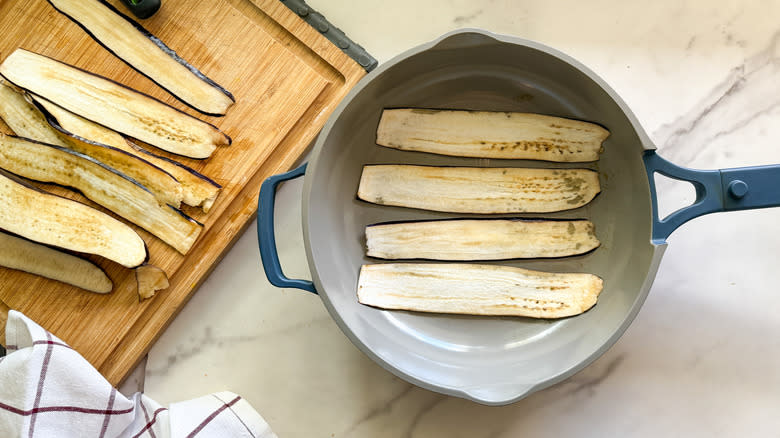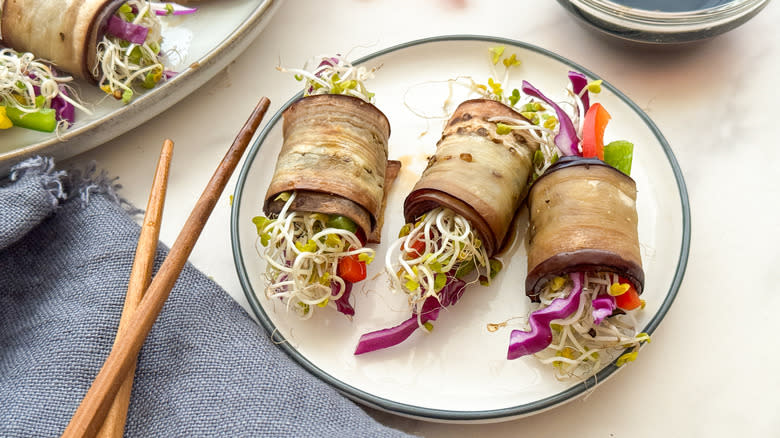Gaji Mari (Korean-Style Eggplant Rolls) Recipe

If you gravitate toward fresh vegetables, there are a number of traditional Korean dishes that incorporate a wide range of vegetables, contributing to the overall balance and healthfulness of the cuisine. Gaji Mari, a rolled eggplant dish, is a popular Korean side dish made from thinly sliced and seasoned eggplant that is rolled into cylindrical shapes around other raw vegetables. The dish is characterized by its visually appealing presentation and savory flavor.
Wellness coach and recipe developer Miriam Hahn brings us this recipe and says, "My favorite thing about this recipe is that you can throw it together in a short amount of time, and it makes a delicious snack. It's also a great way to encourage kids to eat more vegetables. Anything rolled up and served with a dipping sauce is extra appealing to children." Keep reading to learn how to whip up this tasty Korean snack or side dish. It just might be your new favorite way to enjoy eggplant.
Read more: 25 Most Popular Snacks In America Ranked Worst To Best
Gather The Ingredients For Gaji Mari

To make this recipe, start in the produce aisle and pick up Chinese eggplant, red bell pepper, yellow bell pepper, green bell pepper, purple cabbage, and broccoli sprouts. "Chinese eggplant (aka Asian eggplant) is the long and skinny type. This gives you that nice purple border on your eggplant rolls as your peeler takes in a little of the vibrant skin," Hahn says. Then, check your pantry for olive oil, salt, and pepper.
Step 1: Prep The Eggplant

Cut off the end of the eggplants and peel the eggplant into strips with a potato peeler, discarding the first piece that is all peel.
Step 2: Add Oil To A Pan

Add 1 tablespoon of oil to a large frying pan and bring the heat to medium.
Step 3: Cook The Eggplant Strips

Put as many eggplant strips as you can fit into your pan and sprinkle with salt and pepper. Cook for 2 minutes on each side, then repeat the process with the remaining oil and eggplant.
Step 4: Layer The Vegetables On The Eggplant

Lay the strips on a cutting board and layer an equal amount of sliced peppers, cabbage, and sprouts at the bottom of each strip.
Step 5: Roll The Eggplant

Roll up the eggplant and filling, placing the seal on the bottom.
Step 6: Serve The Gaji Mari

The gaji mari is ready to serve with soy sauce on the side for dipping, if desired.
How Can I Customize The Gaji Mari?

You have quite a bit of flexibility with the vegetables used for the eggplant rolls. Julienned carrots, cucumber, or green cabbage can be used in place of or in addition to the core ingredients. Incorporate fresh herbs such as cilantro, parsley, or chives into the filling for added freshness. Include pickled vegetables like radishes or daikon for a tangy kick. The acidity can balance the richness of the eggplant.
To kick up the spice level, add a pinch of red pepper flakes or gochugaru (Korean red pepper flakes) to the sauce for a bit of heat. You can also include finely chopped fresh chili peppers. Toasted sesame seeds can add a nutty flavor and a bit of crunch to the gaji mari. Sprinkle them over the eggplant before rolling for added texture. If you want the gaji mari to be more of a meal, add a protein filling. Thin slices of cooked beef, shredded chicken, or even a layer of tofu can provide additional substance and flavor.
What Can I Pair With The Gaji Mari?

Serve gaji mari with steamed white or brown rice. The rice provides a neutral base that complements the savory and slightly tangy flavors of the rolled eggplant. You can also enjoy gaji mari with a side of traditional Korean kimchi. The spicy, fermented vegetables can add a vibrant kick to the meal.
A bowl of miso soup with tofu and seaweed provides a comforting and umami-rich addition to the gaji mari. Miyeokguk, a Korean seaweed soup often enjoyed on special occasions, makes for a comforting and nutritious accompaniment. Prepare a side of sesame spinach salad, a classic Korean dish made up of blanched spinach dressed in a savory sesame dressing.
Gaji mari can also be part of a bibimbap bowl, a Korean dish featuring mixed rice topped with vegetables, a fried egg, and spicy gochujang (red chili paste). Gaji mari also pairs nicely with dubu jorim, braised tofu in a savory, soy-based sauce. The combination offers a mix of textures and flavors. Enjoy gaji mari with soy-glazed chicken wings for a combination of flavors ranging from sweet and savory to umami. Gaji mari also makes for a nice pairing with grilled fish or seafood dishes. The lightness of the fish complements the richness of the rolled eggplant.
Gaji Mari (Korean-Style Eggplant Rolls) Recipe

Prep Time: 10mCook Time: 16mYield: 2 ServingsIngredients
3 Chinese eggplants
4 tablespoons olive oil, divided
½ teaspoon salt
¼ teaspoon black pepper
½ red bell pepper, sliced thin
½ yellow bell pepper, sliced thin
½ green bell pepper, sliced thin
¼ cup thinly sliced purple cabbage
¼ cup broccoli sprouts
Optional Ingredients
Soy sauce, for serving
Directions
Cut off the end of the eggplants and peel the eggplant into strips with a potato peeler, discarding the first piece that is all peel.
Add 1 tablespoon of oil to a large frying pan and bring the heat to medium.
Put as many eggplant strips as you can fit into your pan and sprinkle with salt and pepper. Cook for 2 minutes on each side, then repeat the process with the remaining oil and eggplant.
Lay the strips on a cutting board and layer an equal amount of sliced peppers, cabbage, and sprouts at the bottom of each strip.
Roll up the eggplant and filling, placing the seal on the bottom.
The gaji mari is ready to serve with soy sauce on the side for dipping, if desired.
Read the original article on Tasting Table.

